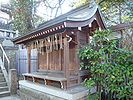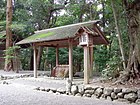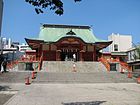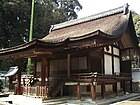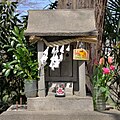Shinto architecture
Shinto architectureis the architecture ofJapaneseShinto shrines.
With a few exceptions likeIse Grand ShrineandIzumo TaishaShinto shrines before Buddhism were mostly temporary structures erected to a particular purpose. Buddhism brought to Japan the idea of permanent shrines and the presence of verandas,stone lanterns,and elaborate gates are some which are used both in a Shinto shrine and a Buddhist temple.
The composition of a Shinto shrine is extremely variable, and none of its possible features are necessarily present. Even thehondenor sanctuary, the part which houses thekamiand which is the centerpiece of a shrine, can be missing. However, since its grounds are sacred, they usually are surrounded by a fence made of stone or wood calledtamagaki,while access is made possible by an approach calledsandō.The entrances themselves are straddled by gates calledtorii,which are therefore the simplest way to identify a Shinto shrine.
A shrine may include within its grounds several structures, each destined to a different purpose.[1]Among them are thehondenor sanctuary, where thekamiare enshrined, theheiden,or hall of offerings, where offers and prayers are presented, and thehaidenor hall of worship, where there may be seats for worshipers.[1]Thehondenis the building that contains theshintai,literally, "the sacred body of thekami".Of these, only thehaidenis open to thelaity.Thehondenis located behind thehaidenand is usually much smaller and unadorned. Other notable shrine features are thetemizuya,the fountain where visitors cleanse their hands and mouth and theshamusho(Xã vụ sở), the office that supervises the shrine.[1]Shrines can be very large, as for exampleIse Shrine,or as small as a beehive, as in the case of thehokora,small shrines frequently found on road sides.
Before the forced separation of Shinto and Buddhism (Shinbutsu bunri), it was not uncommon for a Buddhist temple to be built inside or next to a shrine or to the contrary for a shrine to include Buddhist subtemples (Shinbutsu shūgō). If a shrine was also a Buddhist temple, it was called ajingu-ji.At the same time, temples in the entire country adopted tutelarykami(chinju(Trấn thủ / trấn chủ)and built temple shrines calledchinjushato house them.[2]After the forcible separation of Buddhist temples and Shinto shrines (shinbutsu bunri) ordered by the new government in theMeiji period,the connection between the two religions was officially severed, but continued nonetheless in practice.
The origin of shrines
[edit]The practice of marking sacred areas began in Japan as early as theYayoi period(from about 500 BC to 300 AD) originating from primalShintotenets. Features in the landscape such as rocks, waterfalls, islands, and especially mountains, were places believed to be capable of attractingkami,and subsequently were worshiped asyorishiro.[3]Originally, sacred places may have been simply marked with a surrounding fence and an entrance gate ortorii.[4]Later, temporary buildings similar to present dayportable shrines[5]were constructed to welcome the gods to the sacred place. Over time the temporary structures evolved into permanent structures that were dedicated to the gods. Ancientshrineswere constructed according to the style of dwellings (Izumo Taisha)[3][6]or storehouses (Ise Grand Shrine).[3][4]The buildings hadgabled roofs,raised floors,plank walls, and werethatchedwith reed or covered withhinoki cypressbark.[4]Such early shrines did not include a space for worship.[3]Three important forms of ancient shrine architectural styles exist:taisha-zukuri,shinmei-zukuri,andsumiyoshi-zukuri.[5][7]They are exemplified byIzumo Taisha,Nishina Shinmei ShrineandSumiyoshi Taisha[8]respectively and date to before 552.[9]According to the tradition ofShikinen sengū-sai(Thức năm dời cung tế),the buildings or shrines were faithfully rebuilt at regular intervals adhering to the original design. In this manner, ancient styles have been replicated through the centuries to the present day.[note 1][6][10][11]
Common features
[edit]
The following is a diagram illustrating the most important elements of aShinto shrine:
- Torii– Shinto gate
- Stone stairs
- Sandō– the approach to the shrine
- Chōzuyaortemizuya– fountain to cleanse one's hands and face
- Tōrō– decorative stone lanterns
- Kagura-den– building dedicated toNōor the sacredkaguradance
- Shamusho– the shrine's administrative office
- Ema– wooden plaques bearing prayers or wishes
- Sessha/massha– small auxiliary shrines
- Komainu– the so-called "lion dogs", guardians of the shrine
- Haiden– oratory
- Tamagaki– fence surrounding thehonden
- Honden– main hall, enshrining thekami.
- On the roof of thehaidenandhondenare visiblechigi(forked rooffinials) andkatsuogi(short horizontal logs), both common shrine ornamentations.
Gate (torii)
[edit]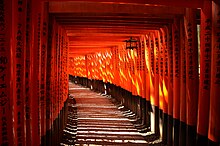
Thetoriiis a gate which marks the entrance to a sacred area, usually but not necessarily a shrine.[12]A shrine may have any number oftorii(Fushimi Inari Taishahas thousands) made of wood, stone, metal, concrete or any other material. They can be found in different places within a shrine's precincts to signify an increased level of holiness.[12]
Toriican often be found also atBuddhist temples,however they are an accepted symbol of Shinto, and as such are used to mark shrines on maps.
The origin of thetoriiis unclear, and no existing theory has been accepted as valid.[12]They may for example have originated in India as a derivative of thetoranagates in the monastery of Sanchi, which is located in central India.[13]
Pathway (sandō)
[edit]Thesandōis the road approaching either aShinto shrineor aBuddhist temple.[14]Its point of origin is usually straddled in the first case by a Shintotorii,in the second by a Buddhistsanmon,gates which mark the beginning of the shrine's or temple territory. There can also bestone lanternsand other decorations at any point along its course. There can be more than onesandō,in which case the main one is calledomote-sandō,or frontsandō,ura-sandō,or rearsandō,etc.
Fountain (chōzuya)
[edit]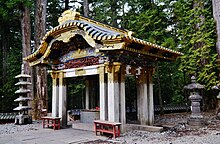
Before entering the shrine, visitors are supposed to wash their hands and mouths at a fountain built to the purpose calledchōzuyaortemizuya.
Guardian lion-dogs (komainu)
[edit]The two "lions" in front of a shrine are in effect warden dogs calledkomainu(Bạc khuyển).They were so called because they were thought to have been brought to Japan from China via Korea, and their name derives fromkoma(Cao Ly),the Japanese term for the Korean kingdom ofKoguryo.[15]They are almost identical, but one has the mouth open, the other closed. This is a very common pattern in statue pairs at both temples and shrines, and has an important symbolic meaning. The open mouth is pronouncing the first letter of thesanskritAlpha bet ( "a" ), the closed one the last ( "um" ), representing the beginning and the end of all things.[16]The one with the open mouth is calledshishi(Sư tử),the otherkomainu,a name that in time came to be used for both animals.[15]
Worship hall (haiden)
[edit]Thehaidenis the hall of worship ororatoryof the shrine. It is generally placed in front of the shrine's main sanctuary (honden) and often built on a larger scale than the latter. Thehaidenis often connected to thehondenby aheiden,or hall of offerings. While thehondenis the place for the enshrinedkamiand off-limits to the general public, thehaidenprovides a space for ceremonies and for worshiping thekami.[17][18]
Offertory hall (heiden)
[edit]Theheidenis the part of a shrine used to house offerings, and normally consists of a section linking thehondenand thehaiden.[19]It can also be calledchūden(Trung điện)or in other ways, and its position can sometimes vary. In spite of its name, nowadays it is used mostly for rituals.
Sanctuary (honden)
[edit]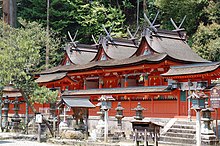
Thehonden,also calledshinden(Thần Điện)is the most sacred building of shrine, intended purely for the use of the enshrinedkami.Thekami,in itself incorporeal, is usually represented physically by a mirror or sometimes by a statue.[20]The building is normally in the rear of the shrine and closed to the general public. The sections Most common shrine stylesandOther stylesbelow are dedicates specifically tohondenand their characteristics.
Other elements
[edit]Hokora
[edit]Ahokoraorhokurais a very smallShinto shrineeither found on the precincts of a larger shrine and dedicated to folkkami,or on a street side, enshriningkaminot under the jurisdiction of any large shrine.[21]Dōsojin,minorkamiprotecting travelers from evil spirits, may for example be enshrined in ahokora.[21]
Sessha, massha
[edit]Sessha(Nhiếp xã,'auxiliary shrine')andmassha(Mạt xã,'branch shrine'),also callededa-miya(Chi cung)[14]are small or miniature shrines having a deep historical relationship with a more important shrine or with thekamiit enshrines, and fall under that shrine's jurisdiction.[22]The two terms used to have different meanings, but must be today considered synonyms. For this reason, this kind of shrine is now sometimes calledsetsumatsusha(Nhiếp mạt xã).[note 2]
Most common shrine styles
[edit]Shrine buildings can have many different basic layouts, usually named either after a famous shrine'shonden(e.g.hiyoshi-zukuri,named afterHiyoshi Taisha), or a structural characteristic (e.g.irimoya-zukuri,after thehip-and-gable roofit adopts. The suffix-zukuriin this case means "structure".)
Thehonden's roof is always gabled, and some styles also have a veranda-like aisle calledhisashi(a 1-ken'wide corridor surrounding one or more sides of the core of a shrine or temple). Among the factors involved in the classification, important are the presence or absence of:
- hirairiorhirairi-zukuri(Bình nhập ・ bình nhập tạo) – a style of construction in which the building has its main entrance on the side which runs parallel to the roof's ridge (non gabled-side). Theshinmei-zukuri,nagare-zukuri,hachiman-zukuri,andhie-zukuribelong to this type.[22]
- tsumairiortsumairi-zukuri(Thê nhập ・ thê nhập tạo) – a style of construction in which the building has its main entrance on the side which runs perpendicular to the roof's ridge (gabled side). Thetaisha-zukuri,sumiyoshi-zukuri,ōtori-zukuriandkasuga-zukuribelong to this type.[22]
Proportions are also important. A building of a given style often must have certain proportions measured inken(the distance between pillars, a quantity variable from one shrine to another or even within the same shrine).
The oldest styles are thetsumairishinmei-zukuri,taisha-zukuri,andsumiyoshi-zukuri,believed to predate the arrival ofBuddhism.[22]
The two most common are thehirairinagare-zukuriand thetsumairikasuga-zukuri.[23]Larger, more important shrines tend to have unique styles.
Nagare-zukuri
[edit]
Thenagare-zukuri(Lưu tạo,'flowing style')ornagare hafu-zukuri(Lưu phá phong tạo,'flowing gabled style')is a style characterized by a very asymmetricalgabledroof (Thiết thê phòng cănkirizuma-yanein Japanese) projecting outwards on the non-gabled side, above the main entrance, to form a portico.[23]This is the feature which gives the style its name, the most common among shrines all over the country.
Sometimes the basic layout consisting of an elevated core(Mẫu phòng,moya)partially surrounded by a veranda calledhisashi(all under the same roof) is modified by the addition of a room in front of the entrance.[23]Thehondenvaries in roof ridge length from 1 to 11ken,but is never 6 or 8ken.[24]The most common sizes are 1 and 3ken.The oldest shrine in Japan,Uji'sUjigami Shrine,has ahondenof this type. Its external dimensions are 5x3ken,but internally it is composed of three sanctuaries(Nội điện,naiden)measuring 1keneach.[24]
Kasuga-zukuri
[edit]Kasuga-zukuri(Ngày xuân tạo)as a style takes its name fromKasuga Taisha'shonden.It is characterized by the extreme smallness of the building, just 1 × 1kenin size. In Kasuga Taisha's case, this translates in 1.9 m × 2.6 m.[25]The roof is gabled with a single entrance at the gabled end, decorated withchigiandkatsuogi,covered with cypress bark and curved upwards at the eaves. Supporting structures are painted vermillion, while the plank walls are white.[25]
After theNagare-zukuri,this is the most common style, with most instances in theKansai regionaround Nara.[23]
Other styles
[edit]Follows a list of other styles (in Alpha betical order). Many are rare, some unique. Most deal with the structure of a single building but others, for example theIshi-no-ma-zukuristyle, define instead the relationship between member structures. In that case, the same building can fall under two separate classifications. For example, thehondenandhaidenatŌsaki Hachimangūare single-storied,irimoya-zukuriedifices.[26]Because they are connected by a passage calledishi-no-maand are covered by a single roof, however, the complex is classified as belonging to theishi-no-ma-zukuri'style (also calledgongen-zukuri).
Gongen-zukuri
[edit]The name comes fromNikkō Tōshō-gūinNikkōbecause it enshrines the Tōshō Daigongen (Tokugawa Ieyasu).
Hachiman-zukuri
[edit]
Hachiman-zukuri(Tám cờ tạo)is a style used atHachimanshrines in which two parallel structures with gabled roofs are interconnected on the non-gabled side, forming one building which, when seen from the side, gives the impression of two.[27]The front structure is calledgaiden(Ngoại điện,outer sanctuary),the rear onenaiden(Nội điện,inner sanctuary),and together they form thehonden.[14]There are entrances at the center of the non-gabled side. In general, the rear structure is 3 × 2ken,while the front one is 3 × 1.
The space between the two structures is onekenwide and forms a room calledai-no-ma(Tương の gian).[27]The actual width and height of this room vary with the shrine.
Extant examples areUsa ShrineandIwashimizu Hachiman-gū.This style, of which only fiveEdo periodexamples survive, may be of Buddhist origin, since some Buddhist buildings show the same division. For example,Tōdai-ji'shokke-dō[note 3]is divided in two sections laid out front and back. Structural details also show a strong relationship with theHeian periodstyle calledshinden-zukuriused in aristocratic residences.[27]Another possible origin of this style may have been early palaces, known to have had parallel ridges on the roof.[27]
Hiyoshi-zukuri
[edit]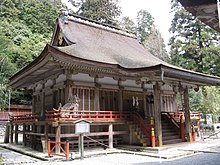
Hiyoshi-zukuri/hie-zukuri(Ngày cát tạo),also calledshōtei-zukuri/shōtai-zukuri(Thánh đế tạo)orsannō-zukuri(Sơn vương tạo)is a rare style presently found in only three instances, all atHiyoshi TaishainŌtsu, Shiga.[23]They are the East and West Honden Hon-gū(Bổn điện bổn cung)and the Sessha Usa Jingū Honden(Nhiếp xã vũ tá thần cung bổn điện).
The building is composed of a 3x2kencore calledmoyasurrounded on three sides by a 1-kenwidehisashi,totaling 5x3ken(see photo).[28]The three-sidedhisashiis unique and typical of this style. The gabled roof extends in smallporticoson the front and the two gabled sides.[23]The roof on the back has a peculiar and characteristic shape.
Irimoya-zukuri
[edit]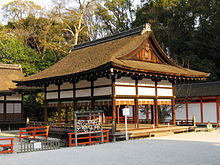
Irimoya-zukuri(Nhập mẫu phòng tạo,lit. hip and gable roof style)is ahondenstyle having ahip[note 4]-and-gable[note 5]structure, that is, a gabled roof with one or two hips, and is used for example inKitano Tenman-gū'shonden.[29]The style is of Chinese origin and arrived in Japan together with Buddhism in the 6th century. It was originally used in theKon-dōandKō-dō(lecture halls) of Buddhist temples, but started to be used also in shrines later, during theJapanese Middle Ages.[30]
The name derives from its hip and gable roof(Nhập mẫu phòng phòng căn,irimoya yane).In Japan the gable is right above the edge of the shrine'smoya,while the hip covers thehisashi.[29]In lay architecture it is often called justmoya-zukuri.Extant examples are Mikami Shrine inShiga prefectureandYasaka Shrinein Kyoto.[29]

Ishi-no-ma-zukuri
[edit]Ishi-no-ma-zukuri(Thạch の gian tạo),also calledgongen-zukuri(権 hiện tạo),yatsumune-zukuri(Tám đống tạo)andmiyadera-zukuri(Cung chùa tạo)is the name of a complex shrine structure in which thehaiden,or worship hall, and thehonden,or main sanctuary, are interconnected under the same roof in the shape of anH.[31]
The connecting passage can be calledai-no-ma(Tương の gian),ishi-no-ma(Thạch の gian),orchūden(Trung điện,intermediate hall).[31]The floor of each of the three halls can be at a different level. If theai-no-mais paved with stones it is calledishi-no-ma,whence the name of the style. It can, however, be paved with planks ortatami.Its width is often the same as thehonden's, with thehaidenfrom one to threekenwider.[31]
One of the oldest examples isKitano Tenman-gūinKyoto.[31]Thegongen-zukuriname comes fromNikkō Tōshō-gūinNikkō,which enshrines the Tōshō Daigongen (Tokugawa Ieyasu) and adopts this structure.[32]
Kibitsu-zukuri
[edit]
Kibitsu-zukuri(Cát bị tân tạo),kibi-zukuri(Cát bị tạo)orhiyoku irimoya-zukuri(Nhập mẫu phòng tạo)is a style characterized by fourdormergables,two per lateral side, on the roof of a very largehonden(sanctuary).[13]The gables are set at a right angle to the main roof ridge, and thehondenis part of a single complex also including ahaiden(worship hall).Kibitsu ShrineinOkayama,Okayama Prefecture,Japanis the sole example of this style.
Misedana-zukuri
[edit]Misedana-zukuri(Thấy thế lều tạo or cửa hàng lều tạo,showcase style)owes its name to the fact that, unlike the other shrine styles, it doesn't feature a stairway at the entrance, and the veranda is completely flat.[23]It is normally used only insesshaandmassha,tiny, 1kenshrines sometimes found on the premises of larger ones. They can however be as small asbeehivesor relatively large and have 1x2, 1x3 or even, in one case, 1x7 bays.[33]Apart from the lack of a staircase, such shrines belong to thenagare-zukuriorkasuga-zukuristyles and have their entrance on the non-gabled (hirairi) or gabled side (tsumairi).
Ōtori-zukuri
[edit]TheŌtori-zukuri(Đại điểu tạo)is atsumairistyle named afterŌtori taishainŌsaka.Its floor is elevated and 2x2kenin size, without a veranda or railings. This style seems to have the same origins as the ancientsumiyoshi-andtaisha-zukuristyles, which it resembles, and the absence of a veranda may be due to the use in origin of an earthen floor, still in use in some shrines.[34]The interior is divided in two,naijin(inner chamber) andgejin(outer chamber).[34]The roof is covered with layers of cypress bark shingles and has a high ridge with an ornamental rather than functional role. It does not curve upwards at the eaves and thebargeboardsare simple and straight.[34]Chigiand threekatsuogiare present.
Owari-zukuri
[edit]
Owari-zukuri(Đuôi trương tạo)is a complex style found in large shrines of what used to be calledOwari province,nearNagoya.[23]It features many structures within the same compound, among them ahonden,ahaiden,atsuriwata-rō(a suspended passageway), ayotsuashimon(a gate built with four pillars), and other buildings. Extant examples of this style includeOwari Ōkunitama ShrineandTsushima Shrine.[23]
Primitive shrine layout withouthonden
[edit]This style is rare, but historically important. It is also unique in that thehonden,normally the very center of a shrine, is missing. It is believed shrines of this type are reminiscent of what shrines were like in prehistorical times. The first shrines had nohondenbecause theshintai,or object of worship, was the mountain on which they stood. An extant example isNara'sŌmiwa Shrine,which still has nohonden.[23]An area near thehaiden(hall of worship), sacred andtaboo,replaces it for worship. Another prominent example of this style isFutarasan Shrinenear Nikkō, whoseshintaiisMount Nantai.For details, seeBirth and evolution of Shinto shrinesabove.
Ryōnagare-zukuri
[edit]Ryōnagare-zukuri(Lạng lưu tạo,double flow style)is an evolution of thenagare-zukuriin which the roof flows down to form a portico on both non-gabled sides.[23]Examples are thehondenatItsukushima Shrineand at Matsuo Taisha.

Shinmei-zukuri
[edit]Shinmei-zukuri(Thần minh tạo)is an ancient style typical of, and most common atIse Grand Shrine,the holiest of Shinto shrines.[23]It is most common in Mie prefecture.[35]Characterized by an extreme simplicity, its basic features can be seen in Japanese architecture from theKofun period(250–538 C.E.) onwards and it is considered the pinnacle of Japanese traditional architecture. Built in planed, unfinished wood, thehondenis either 3x2kenor 1x1kenin size, has a raised floor, a gabled roof with an entry on one the non-gabled sides, no upward curve at the eaves, and decorative logs calledchigiandkatsuogiprotruding from the roof's ridge.[35]The oldest extant example isNishina Shinmei Shrine,the shrine which gives the style its name.[22]
Sumiyoshi-zukuri
[edit]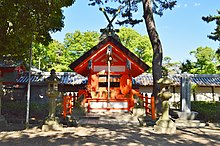
Sumiyoshi-zukuri(Trụ cát tạo)takes its name fromSumiyoshi-taisha'shondeninŌsaka.The building is 4kenwide and 2kendeep, and has an entrance under the gable.[36]Its interior is divided in two sections, one at the front (gejin(Ngoại trận)) and one at the back (naijin(Nội trận)) with a single entrance at the front.[37]Construction is simple, but the pillars are painted in vermilion and the walls in white.
The style is supposed to have its origin in old palace architecture[37]Another example of this style is Sumiyoshi Jinja, part of theSumiyoshi Sanjincomplex inFukuoka Prefecture.[37]In both cases, as in many others, there is no veranda.
Taisha-zukuri
[edit]Taisha-zukuriorŌyashiro-zukuri(Đại xã tạo)is the oldest shrine style, takes its name fromIzumo Taishaand, like Ise Grand Shrine's, haschigiandkatsuogi,plus archaic features like gable-end pillars and a single central pillar (shin no mihashira).[23]Because its floor is raised on stilts, it is believed to have its origin in raised-floor granaries similar to those found inToro,Shizuoka prefecture.[38]
Thehondennormally has a 2x2kenfootprint (12.46x12.46 m in Izumo Taisha's case), with an entrance on the gabled end. The stairs to the honden are covered by a cypress bark roof. The oldest extant example of the style isKamosu Jinja'shondeninShimane Prefecture,built in the 16th century.
Gallery
[edit]-
A metaltorii
-
Asandō
-
Atemizuya
-
Akomainu
-
Izumo Taisha'shonden
-
Hanazono Jinja'shaiden
-
Kasuga Taisha'sheiden
-
Hirairistyle: entrance on the non-gabled side
-
The typical shape of the back of aHiyoshi-zukuriroof
-
Ahokora
-
Ōtori-zukuri
-
Ōtori Taisha'shonden
-
Somesetsumatsusha
-
Shinmei-zukuri
-
Sumiyoshi-zukuri
-
Taisha-zukuri,Izumo Taisha
See also
[edit]Notes
[edit]- ^Presently only theIse Grand Shrineis being rebuilt every 20 years.
- ^The termsetsumatsushais the combination of the two termssesshaandmassha.
- ^Literally "Lotus SūtraHall. A hall whose layout allows walking around a statue for meditation
- ^A hip roof, or hipped roof, is a type of roof where all sides slope downwards to the walls, usually with a fairly gentle slope.
- ^A gable is the generally triangular portion of a wall enclosed between the edges of a sloping roof.
References
[edit]- ^abcThe History of Shrines,Encyclopedia of Shinto,retrieved on June 10, 2008
- ^Mark Teeuwen inBreen and Teeuwen(2000:95-96)
- ^abcdYoung & Young 2007,p. 50
- ^abcFletcher & Cruickshank 1996,p. 724
- ^abNishi & Hozumi 1996,p. 40
- ^abKishida 2008,p. 33
- ^Kishida 2008,p. 34
- ^Kishida 2008,p. 35
- ^Kishida 2008,p. 126
- ^Nishi & Hozumi 1996,p. 41
- ^Kuroda 2005
- ^abcEncyclopedia of ShintoTorii,accessed on December 15, 2009
- ^abJAANUS,Toriiaccessed on December 12, 2009
- ^abcIwanamiKōjien(Quảng từ uyển)Japanese dictionary, 6th Edition (2008), DVD version.
- ^abJAANUS,Komainu,accessed on November 8, 2009
- ^JAANUS,A un,accessed on November 8, 2009
- ^Mori, Mizue (2005-06-02)."Haiden".Encyclopedia of Shinto(β1.3 ed.).Tokyo:Kokugakuin University.Retrieved2009-11-16.
- ^"haiden".JAANUS - Japanese Architecture and Art Net User System.Retrieved2009-11-08.
- ^Heiden,JAANUS,accessed on November 17, 2009
- ^Shinden,Encyclopædia Britannica
- ^abEncyclopedia of Shinto,Hokora.Accessed on December 14, 2009
- ^abcde"Sessha - Massha"(in Japanese). Yahoo! Japan. Archived fromthe originalon 19 December 2012.Retrieved5 December2009.
- ^abcdefghijklmEncyclopedia of Shinto,History and Typology of Shrine Architecture,accessed on November 29, 2009
- ^abJAANUS,Nagare-zukuri,accessed on December 1, 2009
- ^abJAANUS,Kasuga-zukuri,accessed on December 1, 2009
- ^"Ōsaki Hachiman Shrine - Information in English"(PDF).Ōsaki Hachiman Shrine.Archived fromthe original(PDF)on 2011-07-22.Retrieved2009-11-04.
- ^abcdJAANUS,Hachiman-zukuriaccessed on December 1, 2009
- ^JAANUS,Hie-zukuri,accessed on December 1, 2009
- ^abcJAANUS,Irimoya-zukuri,accessed on December 1, 2009
- ^Iwanami Nihonshi Jiten ( nham sóng Nhật Bản sử từ điển ), CD-Rom Version. Iwanami Shoten, 1999-2001.
- ^abcdEncyclopedia of Shinto,Gongen-zukuriaccessed on December 2, 2009
- ^Jaanus,Gongen-zukuri,accessed on December 5, 2009
- ^JAANUS,Misedana-zukuri,accessed on December 1, 2009.
- ^abcJAANUS,Ootori-zukuri,accessed on December 1, 2009
- ^abJAANUS,Shinmei-zukuriaccessed on December 1, 2009
- ^Jinja Kenchiku,ShogakukanNihon Daihyakka Zensho, accessed on November 29, 2009
- ^abcJAANUS,Sumiyoshi-zukuri,accessed on December 1, 2009
- ^JAANUS,Taisha-zukuri,accessed on December 1, 2009
Bibliography
[edit]- Fletcher, Sir Banister;Cruickshank, Dan (1996) [1896].Sir Banister Fletcher's a history of architecture(20th illustrated ed.). Architectural Press.ISBN0-7506-2267-9.Retrieved2009-11-11.
- Kishida, Hideto (2008).Japanese Architecture.READ BOOKS.ISBN978-1-4437-7281-5.Retrieved2009-11-11.
- Kuroda, Ryūji (2005-06-02)."History and Typology of Shrine Architecture".Encyclopedia of Shinto(β1.3 ed.).Tokyo:Kokugakuin University.Retrieved2009-11-16.
- Nishi, Kazuo; Hozumi, Kazuo (1996) [1983].What is Japanese architecture?(illustrated ed.). Kodansha International.ISBN4-7700-1992-0.Retrieved2009-11-11.
- Watanabe, Yasutada (1974).Shinto art: Ise and Izumo shrines.New York, Tokyo:Weatherhill/Heibonsha.
- Young, David; Young, Michiko (2007) [2004].The art of Japanese architecture.Architecture and Interior Design (illustrated, revised ed.). Tuttle Publishing.ISBN978-0-8048-3838-2.Retrieved2009-11-11.

